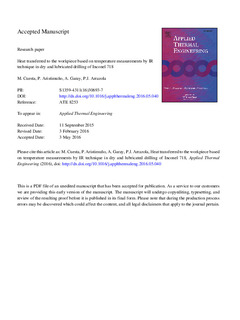Title
Heat transferred to the workpiece based on temperature measurements by IR technique in dry and lubricated drilling of Inconel 718Version
Postprint
Rights
© 2016 ElsevierAccess
Open accessPublisher’s version
https://doi.org/10.1016/j.applthermaleng.2016.05.040Published at
Applied Thermal Engineering Vol. 104. Pp. 309–318. July, 2016xmlui.dri2xhtml.METS-1.0.item-publicationfirstpage
309xmlui.dri2xhtml.METS-1.0.item-publicationlastpage
318Publisher
ElsevierKeywords
Heat partition
Infrared thermography
Inconel 718
Temperature ... [+]
Infrared thermography
Inconel 718
Temperature ... [+]
Heat partition
Infrared thermography
Inconel 718
Temperature
Drilling
Lubricated [-]
Infrared thermography
Inconel 718
Temperature
Drilling
Lubricated [-]
Abstract
In manufacturing aeronautical critical components, such as turbine discs commonly made of Inconel 718, surface integrity is crucial to ensure their fatigue life. Among the machining processes used, th ... [+]
In manufacturing aeronautical critical components, such as turbine discs commonly made of Inconel 718, surface integrity is crucial to ensure their fatigue life. Among the machining processes used, the drilling operation is one of the most critical as overheating can occur causing thermal damage to the hole. The amount of heat dissipated could determine the nature of deformation in the machining of Inconel 718. Nevertheless no detailed studies have determined experimentally the differences between the fractions of heat transferred to the workpiece (β) for dry and lubricated drilling. In this context, the thermal and mechanical loads (measured by IR technique and a piezoelectric dynamometer) affecting the drilling of Inconel 718 have been studied. Four different cutting conditions both in dry and lubricated conditions were tested. In order to obtain β, the study presents a model based on a new experimental method. The maximum β values were achieved in the unlubricated tests (around 0.20). By contrast, in the lubricated tests β range from 0.065 to 0.078. Therefore the fraction of heat conducted to the workpiece show maximum differences of 72% and minimum of 57% depending on the application or not application of coolant. Additionally, the obtained trends of β relative to Peclet number (that is dependent on the cutting speed, feed and drill diameter) are shown. [-]
Collections
- Articles - Engineering [735]





















